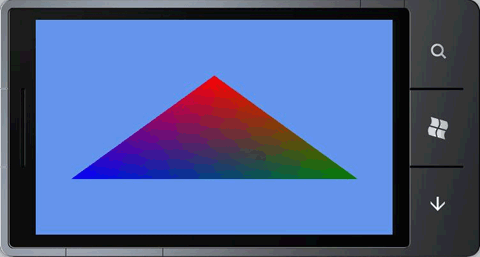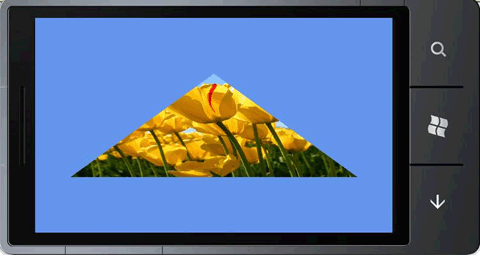Windows Phone 7对3D的支持还是不错的,据说是用OpenGL/ES做的,使用起来倒是也有点那种感觉。本文就不讲XNA 4.0的游戏框架了,直接上一段代码,该代码使用VertexPositionColor渲染了一个三角形,程序运行一切正常。
2.
运行结果如下:

在确认了3D开发的这种代码结构以后,用VertexPositionTexture渲染同样的三角形,只是这次采用纹理贴图,代码如下:
2. view plaincopy to clipboardprint?
3. VertexPositionTexture[] trangleTexture;
4.
5. protected override void LoadContent()
6. {
7. spriteBatch =new SpriteBatch(GraphicsDevice);
8.
9. image = Content.Load<Texture2D>(@"Images/Tulips");
10. trangleTexture =new VertexPositionTexture[]{
11. new VertexPositionTexture(new Vector3(0, 1, 0),new Vector2(0.5f,0) ),
12. new VertexPositionTexture(new Vector3(1, -1, 0),new Vector2(1,1f) ),
上海徐汇企业网站制作"color: #000000;">13. new VertexPositionTexture(new Vector3(-1,-1, 0),new Vector2(0,1f) )
14. };
15.
16. vertexBuffer =new VertexBuffer(GraphicsDevice, typeof(VertexPositionTexture), trangleTexture.Length, BufferUsage.None);
17. vertexBuffer.SetData<VertexPositionTexture>(trangleTexture);
18.
19. basicEffect =new BasicEffect(GraphicsDevice);
20.
21. GraphicsDevice.SetVertexBuffer(vertexBuffer);
22. }
23.
24. protected override void Draw(GameTime gameTime)
25. {
26. GraphicsDevice.Clear(Color.CornflowerBlue);
27.
28. basicEffect.World = world;
29. basicEffect.View = camera.view;
30. basicEffect.Projection = camera.projection;
31. basicEffect.Texture = image;
32. basicEffect.TextureEnabled =true;
33.
34. foreach (EffectPass pass in basicEffect.CurrentTechnique.Passes)
35. {
36. pass.Apply();
37. GraphicsDevice.DrawUserPrimitives<VertexPositionTexture>(PrimitiveType.TriangleStrip, trangleTexture, 0, 1);
38. }
39. base.Draw(gameTime);
40. }
啰嗦一句,在此代码中VertexPositionTexture的第二个Vetex2代表的是UV坐标,对应的含义是(0,0)点对应了纹理图片的左上角,(1,1)点对应了纹理图片的右下角。
上述代码在运行的时候会在VS2010的输出窗口中显示:
| A first chance exception of type 'System.NotSupportedException' occurred in Microsoft.Xna.Framework.Graphics.dll A first chance exception of type 'System.Threading.ThreadAbortException' occurred in Microsoft.Xna.Framework.dll |
同时模拟器里的程序直接退出,看不到结果。原因是什么呢?疑惑并仔细检视代码中……
与前一个彩色三角形对比,顶点顺序没变,摄像机位置没变,投影矩阵没变,按说是不可能出现这种问题的,而且程序直接崩了,没有信息抛出,真是很郁闷。
经过不断的试错,在宣布放弃之前,忽然想起来关于纹理方面的一个注意事项。有过3D开发经验的朋友都知道,纹理是要求符合2的整数次方对齐的,而我所加载的来自于外部任意图片的纹理不符合这一要求,所以程序挂了。
又查了一些资料,找到了准确的原因。原来是Windows Phone 7 的XNA中默认的纹理寻址模式使用了Wrap,造成了与GPU的不兼容,如果改成Clamp就好了。
看来在这个地方微软得要有文档说明才好,否则还真是难找问题所在。修改后的代码如下:
2. protected override void LoadContent()
3. {
4. // Create a new SpriteBatch, which can be used to draw textures.
5. spriteBatch =new SpriteBatch(GraphicsDevice);
6.
7. image = Content.Load<Texture2D>(@"Images/Tulips");
8.
9. trangleTexture =new VertexPositionTexture[]{
10. new VertexPositionTexture(new Vector3(0, 1, 0),new Vector2(0.5f,0) ),
11. new VertexPositionTexture(new Vector3(1, -1, 0),new Vector2(1,1f) ),
12. new VertexPositionTexture(new Vector3(-1,-1, 0),new Vector2(0,1f) )
13. };
14.
15. vertexBuffer =new VertexBuffer(GraphicsDevice, typeof(VertexPositionTexture), trangleTexture.Length, BufferUsage.None);
16. vertexBuffer.SetData<VertexPositionTexture>(trangleTexture);
17.
18. basicEffect =new BasicEffect(GraphicsDevice);
19.
20. GraphicsDevice.SetVertexBuffer(vertexBuffer);
21. GraphicsDevice.SamplerStates[0] = SamplerState.PointClamp;
22. }
23.
最终的模拟器结果是:

不管怎么说,Windows Phone 7的XNA游戏开发框架以及3D方面的开发接口还是很出色的,顶一下微软,并希望这个平台能尽快发展起来。
附Camera的代码:
2. using System;
3. using System.Collections.Generic;
4. using System.Linq;
5. using Microsoft.Xna.Framework;
6. using Microsoft.Xna.Framework.Audio;
7. using Microsoft.Xna.Framework.Content;
8. using Microsoft.Xna.Framework.GamerServices;
9. using Microsoft.Xna.Framework.Graphics;
10. using Microsoft.Xna.Framework.Input;
11. using Microsoft.Xna.Framework.Media;
12.
13.
14
15. {
16. publicclass Camera : Microsoft.Xna.Framework.GameComponent
17. {
18. public Matrix view{get;protected set;}
19. public Matrix projection { get; protected set; }
20.
21. public Camera(Game game,Vector3 pos,Vector3 target,Vector3 up)
22. : base(game)
23. {
24. view = Matrix.CreateLookAt(pos, target, up);
25. projection = Matrix.CreatePerspectiveFieldOfView(MathHelper.PiOver4, (float)game.Window.ClientBounds.Width / (float)game.Window.ClientBounds.Height, 1, 100);
26. }
27.
28. public override void Initialize()
29. {
30. base.Initialize();
31. }
32.
33. public override void Update(GameTime gameTime)
34. {
35. base.Update(gameTime);
36. }
37. }
38. }
39.
























 9374
9374

 被折叠的 条评论
为什么被折叠?
被折叠的 条评论
为什么被折叠?








